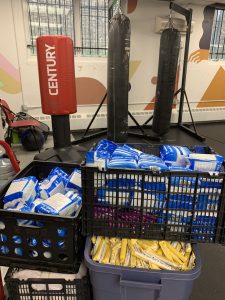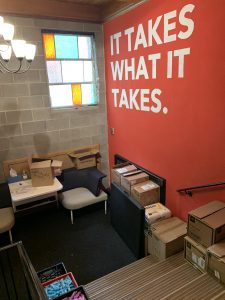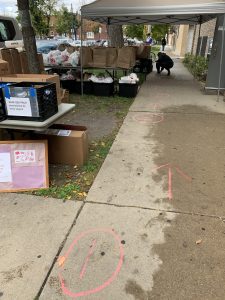Gray skies and clouds signal spotted rain showers above the heads of folks bundled in their winter coats, lining their carritos up along the side of a former church on Karlov and Kamerling Ave. They know the drill. Line up and wait for their number to be called, a recent change added to prevent arguments over who was there first or who stepped out of line. It’s the first Friday of October, and although distribution begins at noon– two hours later– the line is already curving around the corner in anticipation of The Bloc’s monthly pantry pop-up.
The Bloc sits in Humboldt Park, Chicago’s West Side neighborhood known for its rich Puerto Rican culture. 55.4 percent of Humboldt Park residents are Hispanic and 30.9 percent have an annual household income of less than $25,000. The statistics are reflected in the line, which consists of mostly middle-aged to elder Latinos.
Prepping the table of hygiene products sparks a comment from one of the volunteers, expressing frustration about her teen daughter who has been giving her period products to other students at their all-girls Catholic high school.
“Well, what if they don’t have products?” Operations Manager Tanya Bermudez asked, matter-of-factly.
This lack of access to menstrual products, hygiene facilities, education or waste management is referred to as period poverty, or menstrual poverty. It’s difficult to pinpoint exactly how many people this phenomenon affects, but according to the Journal of Global Health Reports, 500 million people lack access to menstrual products and hygiene facilities worldwide, and in the U.S.,16.9 million people who menstruate live in poverty.
An obvious contributor to period poverty is cost. Illinois eliminated the tampon tax in 2016, although 22 states still tax menstrual products as luxury items. Prices of products vary depending on brand, preferred product type and flow–but menstruating is expensive. In fact, CVS recently announced a plan to reduce the price of their brand of period products by 25 percent to promote menstrual equity. Monthly tampon use over a person’s lifetime is estimated to cost $1,800 and the price is increasing.
This year, inflation and supply chain issues raised the average price of menstrual pads by 8.3 percent and tampons by 9.8, according to NielsenIQ. For people already struggling to get by, this can be the difference between having a healthy period or having money for groceries.


Product distribution, like The Bloc’s pantry pop-up, are community-driven solutions attempting to bridge the gap towards product access. The Bloc originated as a free youth mentor and boxing program, but has expanded its services and now offers free groceries, cleaning supplies, period products and more on a biweekly basis.
When Bermudez joined The Bloc in September 2021, she saw an immediate need to reorganize the type of period products being ordered for distribution.
“Right away I knew we had way too many tampons, I know that this demographic wants pads, like I just already knew that,” Bermudez said.
A study of low-income women between the ages of 18 to 35 showed that 22 percent of English-speaking Latinas and only 5 percent of Spanish-speaking Latinas used tampons in adolescence, citing concerns that tampons were inappropriate for virgins or that they didn’t know how to use them.
Tanya explained her experience growing up in a Latino household, “It was very taboo to even talk about. I was very curious and you know, my mother, me regañaba if I had wanted to use a tampon. It’s like no, you’re not supposed to use that and I didn’t know why, that was never explained to me.”
Ida Melbye runs The Period Collective, a Chicago-based nonprofit that provides period products to many organizations throughout the state, including The Bloc. She also noticed this preference.
“I hardly ever get ‘we prefer tampons over pads’ but I get all the time ‘we prefer pads over tampons,’ I think that it is partially cultural, partially it’s an age thing,” she said.


As the distribution begins, this becomes evident. The menstrual product station is the first table in the lineup of donations, and the first few women in line rush over to stock up on boxes of menstrual pads and pantyliners. They glaze over the crates of shiny blue and purple tubes. Tampons are left behind as pads fly off the table. This predominantly Latino community demonstrates an aspect of culture that shies away from insertable products like tampons.
Although this option isn’t as popular, Bermudez is passionate about including as many different brands and product types as possible. She explained that it allows people to test new things without taking a gamble.
“If you’re curious you can try it and not have to pay for a box of stuff you’re not going to be able to use.” she said. “I want to make variety accessible.”
A 20-something-year-old mom approached the table and grabbed two boxes of product, reaching for an additional handful of individually wrapped pads. Her toddler son, wearing a Pickachu-yellow Pokeman jacket, balanced a stack of white maxi pads tucked under his chin for support as his mother guided him towards the next station.
By 12:25 p.m. there was a huge dent in the amount of products left, versus the amount that lined the hallways earlier that morning. Crates, bins, and boxes full of product sat along stairs and training areas of the gym. By the end of distribution, only tampons will be left.
“Those go back in the bin for next time,” said Bermudez.
Community food pantries and free products won’t solve the issue of period poverty alone. Organizers and politicians in Illinois have implemented legislation, and are crafting more, to support menstrual equity in the state. It’s a fight that continues, because whether products are affordable or not, and whether legislation supports it or not, people are going to menstruate.
“We would need trucks full of pallets to fill the need. It’s never enough.”
_________________________________________________________________________________
Publisher’s note: “Period Poverty in Illinois: Community-Driven Solutions” is part of a series of stories on period poverty in Illinois supported by the USC-Annenberg Center for Health Journalism. ILLN Editor, Reporter Annabel Rocha was selected as a 2022 National Fellow to explore challenges impacting child, youth and family health and well-being in the U.S.
ILLN views our audience as collaborators and in covering this topic, we need your help.
We want to know your experiences dealing with menstruation and/or period poverty. In collecting this information, we hope to gain insight on how this issue affects those in our communities. Please consider participating in the Addressing Period Poverty or Abordando La Pobreza Menstrual surveys.
We hope to use the data collected from this survey to shape our storytelling and provide the answers you most want to hear.
For more information please contact annabel@latinonewsnetwork.com.
